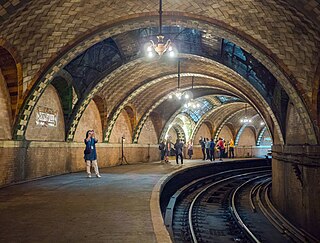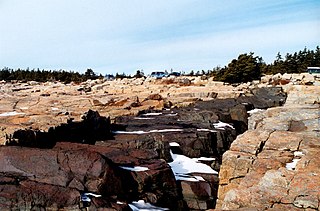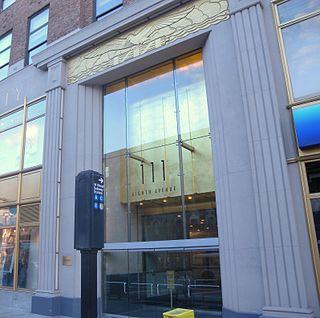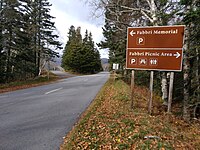
The Brooklyn Bridge is a hybrid cable-stayed/suspension bridge in New York City, spanning the East River between the boroughs of Manhattan and Brooklyn. Opened on May 24, 1883, the Brooklyn Bridge was the first fixed crossing of the East River. It was also the longest suspension bridge in the world at the time of its opening, with a main span of 1,595.5 feet (486.3 m) and a deck 127 ft (38.7 m) above mean high water. The span was originally called the New York and Brooklyn Bridge or the East River Bridge but was officially renamed the Brooklyn Bridge in 1915.

NYNEX Corporation was an American telephone company that served five states of New England as well as most of the state of New York from January 1, 1984 to August 14, 1997.

The City Hall station, also known as City Hall Loop station, is a closed station on the IRT Lexington Avenue Line of the New York City Subway. It is located under City Hall Park, next to New York City Hall, in the Civic Center neighborhood of Manhattan in New York City. The station was constructed for the Interborough Rapid Transit Company (IRT) as the southern terminal of the city's first subway line, which was approved in 1900. Construction of the segment of the line that includes the City Hall station started on September 12 of the same year. The station opened on October 27, 1904, as one of the original 28 stations of the New York City Subway. As ridership grew, it was deemed infeasible to lengthen the original platform to accommodate ten-car trains. The station was closed on December 31, 1945, because of its proximity to the Brooklyn Bridge station.
The BMT Nassau Street Line is a rapid transit line of the B Division of the New York City Subway system in Manhattan. At its northern end, the line is a westward continuation of the BMT Jamaica Line in Brooklyn after the Jamaica Line crosses the Williamsburg Bridge into Manhattan. The Nassau Street Line continues south to a junction with the BMT Broadway Line just before the Montague Street Tunnel, after which the line reenters Brooklyn. Although the tracks merge into the Broadway Line south of Broad Street, there has been no regular service south of the Broad Street station since June 25, 2010. While the line is officially recognized as the Nassau Street Line, it only serves one station on Nassau Street: Fulton Street.

WKCR-FM is a radio station licensed to New York, New York. The station is owned by Columbia University and serves the New York metropolitan area. Founded in 1941, the station traces its history back to 1908 with the first operations of the Columbia University Radio Club (CURC). In 1956, it became one of the first college radio stations to adopt FM broadcasting, which had been invented two decades earlier by Professor Edwin Howard Armstrong. The station was preceded by student involvement in W2XMN, an experimental FM station founded by Armstrong, for which the CURC provided programming. Originally an education-focused station, since the Columbia University protests of 1968, WKCR-FM has shifted its focus towards alternative musical programming, with an emphasis on jazz, classical, and hip-hop.

The Schoodic Peninsula is a peninsula in Down East Maine. It is located four miles (6 km) east of Bar Harbor, Maine, as the crow flies. The Schoodic Peninsula contains 2,266 acres (9 km2), or approximately 5% of Acadia National Park. It includes the towns of Gouldsboro and Winter Harbor. The peninsula has a rocky granite shoreline containing many volcanic dikes. The peninsula is home to the former United States Navy base, NSGA Winter Harbor, which has been converted into a National Park Service training center. A 3,300-acre (13 km2) resort development was proposed for land abutting Schoodic Peninsula's national park holdings to the north. An anonymous donor eventually bought the entire 3,200-acre tract and built the Schoodic Woods Campground and miles of gravel bike paths before donating all of it to Acadia National Park. Opening in 2015, Schoodic Woods is the newest campground in Acadia National Park, and the first built in the park since the original campgrounds were built by the Civilian Conservation Corps during the Great Depression beginning in 1936. In the summer, the Schoodic peninsula is currently served by two separate ferry services from Bar Harbor to Winter Harbor that run daily.

Yan Huiqing was a Chinese diplomat and politician who served under the Qing Dynasty, the Republic of China and the People's Republic of China. He held the title of jinshi in the imperial bureaucracy. Notably, he served briefly as Premier and later President of the Republic of China in the 1920s, and, shortly before his death, became a member of the National Committee of the Chinese People's Political Consultative Conference.

The David N. Dinkins Municipal Building is a 40-story, 580-foot (180 m) building at 1 Centre Street, east of Chambers Street, in the Civic Center neighborhood of Manhattan in New York City. The structure was built to accommodate increased governmental space demands after the 1898 consolidation of the city's five boroughs. Construction began in 1909 and continued through 1914 at a total cost of $12 million.

The South Ferry/Whitehall Street station is a New York City Subway station complex in the Financial District neighborhood of Manhattan, under Battery Park. The complex is shared by the IRT Broadway–Seventh Avenue Line and the BMT Broadway Line. It is served by the 1 and R trains at all times, the W train only on weekdays during the day, and the N train at night.

The Canal Street station is a New York City Subway station complex. It is located in the neighborhoods of Chinatown and SoHo in Manhattan and is shared by the BMT Broadway Line, the IRT Lexington Avenue Line, and the BMT Nassau Street Line. It is served by the 6, J, N, and Q trains at all times; the R train at all times except late nights; the W train during weekdays; the <6> train during weekdays in the peak direction; the Z train during rush hours in the peak direction; and the 4 train during late nights.

The 14th Street/Eighth Avenue station is an underground New York City Subway station complex shared by the IND Eighth Avenue Line and the BMT Canarsie Line. Located at Eighth Avenue and 14th Street in Manhattan, the station is served by the A, E, and L trains at all times and the C train at all times except late nights.

U.S. Naval Radio Station Otter Cliffs was a United States Navy radio receiver facility located in Acadia National Park on Mount Desert Island, south of Bar Harbor, Maine.

Naval Security Group Activity, Winter Harbor was a radio station of the United States Navy that operated from 1935 to 2002.
Fabbri is an Italian surname. Notable people with the name include:

Pier A, also known as City Pier A, is a pier in the Hudson River at Battery Park in Lower Manhattan, New York City. It was built from 1884 to 1886 as the headquarters of the New York City Board of Dock Commissioners and the New York City Police Department (NYPD)'s Harbor Department. Pier A, the only remaining masonry pier in New York City, contains a two- and three-story structure with a clock tower facing the Hudson River. The pier is a New York City designated landmark and is listed on the National Register of Historic Places (NRHP).

The Brooklyn Navy Yard is a shipyard and industrial complex in northwest Brooklyn in New York City, New York, U.S. The Navy Yard is located on the East River in Wallabout Bay, a semicircular bend of the river across from Corlears Hook in Manhattan. It is bounded by Navy Street to the west, Flushing Avenue to the south, Kent Avenue to the east, and the East River on the north. The site, which covers 225.15 acres (91.11 ha), is listed on the National Register of Historic Places.

The Brooklyn Bridge–City Hall/Chambers Street station is a New York City Subway station complex in Lower Manhattan. The complex is served by trains of the IRT Lexington Avenue Line and the BMT Nassau Street Line. The station is served by the 4, 6, and J trains at all times; the 5 train at all times except late nights; the <6> train during weekdays in the peak direction; and the Z train during rush hours in the peak direction.

The Battery, formerly known as Battery Park, is a 25-acre (10 ha) public park located at the southern tip of Manhattan Island in New York City facing New York Harbor. It is bounded by Battery Place on the north, with Bowling Green to the northeast, State Street on the east, New York Harbor to the south, and the Hudson River to the west. The park contains attractions such as an early 19th-century fort named Castle Clinton; multiple monuments; and the SeaGlass Carousel. The surrounding area, known as South Ferry, contains multiple ferry terminals, including the Staten Island Ferry's Whitehall Terminal; a boat launch to the Statue of Liberty National Monument ; and a boat launch to Governors Island.

Franz Kneisel was a violinist, conductor, and music teacher.

Park Loop Road is a scenic road through part of Acadia National Park in Maine, United States. 27 miles (43 km) long, it traverses the eastern side of Mount Desert Island in a (mostly) one-way, clockwise direction, from Bar Harbor to Seal Harbor. The road is two-way for a section between Wildwood Stables, toward the middle of Mount Desert Island, and the Hulls Cove entrance near Bar Harbor. A toll is required for vehicles continuing on the Loop Road beyond the entrance station immediately inland from Schooner Head overlook; the 5.3-mile (8.5 km) section between Paradise Hill Road, at the foot of Cadillac Mountain, and the entrance station is toll-free.




















